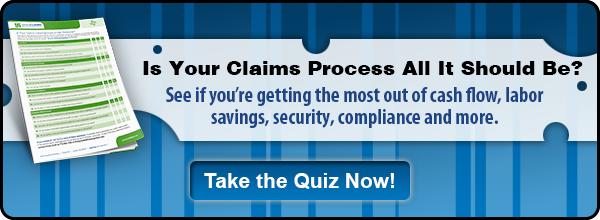With a Claims Management Solution - The gift that keeps on paying
 Admittedly, the reimbursement process is complicated. Not only must billers identify who is to pay the bill, they have to know how to bill the payer and get paid as quickly as possible. This is especially the case when billing third party payers, such as Medicare, Medicaid, Managed Care, and private insurances. Each has its own requirements as far as coding, bill timing, and claims processing quirks are concerned which seem to change frequently. If billers are having to prepare, process, track, and follow up with claims manually using spreadsheets, phone calls, emails, letters, logs, and on and on, it is no wonder that billers are stressed and overwhelmed, that dollars are left on the table and claims are lost or misplaced. Reimbursement, or revenue cycle management, does not have to be complicated, however. In fact, it can be relatively simple with an automated claims management solution through a claims clearinghouse. But, buyers beware. Let’s take a closer look.
Admittedly, the reimbursement process is complicated. Not only must billers identify who is to pay the bill, they have to know how to bill the payer and get paid as quickly as possible. This is especially the case when billing third party payers, such as Medicare, Medicaid, Managed Care, and private insurances. Each has its own requirements as far as coding, bill timing, and claims processing quirks are concerned which seem to change frequently. If billers are having to prepare, process, track, and follow up with claims manually using spreadsheets, phone calls, emails, letters, logs, and on and on, it is no wonder that billers are stressed and overwhelmed, that dollars are left on the table and claims are lost or misplaced. Reimbursement, or revenue cycle management, does not have to be complicated, however. In fact, it can be relatively simple with an automated claims management solution through a claims clearinghouse. But, buyers beware. Let’s take a closer look.
Keeping it simple – clearinghouse musts
Let’s assume that the strengths of automating claims management are a given. Specific clearinghouse features can considerably contribute to claims management simplicity. To help simplify and accelerate converting revenue to cash, a clearinghouse, like primeCLAIMS, should be able to do the following:
- In the event a claim is rejected, the clearinghouse should be able to isolate specific claims, not reject the entire batch of claims.
- The solution should give billers the ability to edit, scrub, monitor, and manage claims throughout the process.
- The clearinghouse must be able to stay on top of the almost daily changes to submission requirements, even the most obscure.
Visibility and control – an AR manager’s dream
Visibility and control with an enterprise-class claims solution also contributes to process simplification. With one log-in:
- Billers can connect directly to all Medicare payers via CMS-approved NSVs (Network Services Providers)
- Billers should have access to tools needed to manage claims, DDE, ADR status tracking, eligibility, secondary billing, and claims denied.
- AR managers can view each facility’s claims status and provide assistance where necessary.
Such simple tools to help speed cash flow with fewer rejections and cleaner claims. They also reduce costs by:
- Eliminating unnecessary paperwork
- Reducing transaction fees
- Reducing labor through elimination of such labor-intensive inefficiencies as:
- Log-ins to multiple systems to view all locations, determine eligibility, edit, and track all claims
- Manually compiling and submitting secondary payer claims
Simplicity in claims processing and managing also delivers peace of mind with:
- HIPAA checks
- Up to 10 years of data stored online
The bottom line
Using a clearinghouse to process, submit, and monitor claims yields numerous cost savings and improved cash flow. It’s much simpler and it just make cents.
/Prime-Care-Technologies-Logo.png?width=191&height=55&name=Prime-Care-Technologies-Logo.png)


 That claims management has an impact on cash flow cannot be denied. But is your solution really working for you? First, let’s identify in what ways a claims management solution helps cash flow by converting into statements the questions found in our recent
That claims management has an impact on cash flow cannot be denied. But is your solution really working for you? First, let’s identify in what ways a claims management solution helps cash flow by converting into statements the questions found in our recent  I acknowledge that blogs are for the purpose of educating and earning your trust, but at times I think it’s alright to blow one’s own horn once in a while. After all no less a business guru than Kenneth H. Blanchard said, “If you don't blow your own horn, someone else will use it as a spittoon.” In the highly competitive world of claims clearinghouses, blowing our own horn is a must and doing it early is essential. Otherwise, the ensuing copycat cacophony will drown it out. So, here it is.
I acknowledge that blogs are for the purpose of educating and earning your trust, but at times I think it’s alright to blow one’s own horn once in a while. After all no less a business guru than Kenneth H. Blanchard said, “If you don't blow your own horn, someone else will use it as a spittoon.” In the highly competitive world of claims clearinghouses, blowing our own horn is a must and doing it early is essential. Otherwise, the ensuing copycat cacophony will drown it out. So, here it is. With all that we’ve been reading about alleged LTC Medicare fraud, overbilling, claiming more services than that which were actually provided, giving incorrect treatments, or up-coding Medicare claims, it’s hard for providers not to feel like a target. Therefore, on behalf of those who are trying to do their best in a world of changing rules, retro reviews, and the dramatic expansion of diagnostic codes, we cry, “Enough already!” We want to speak out for all providers who are doing their best and are NOT trying to rip the system. We believe that the majority of providers operate with integrity and with the intent to provide service consistent with each resident’s needs. Personally, I take exception to any outcry that providers are gaming the system before all the evidence is in place – makes good headlines, but poor policymaker/provider relationships and certainly LOUSY policy.
With all that we’ve been reading about alleged LTC Medicare fraud, overbilling, claiming more services than that which were actually provided, giving incorrect treatments, or up-coding Medicare claims, it’s hard for providers not to feel like a target. Therefore, on behalf of those who are trying to do their best in a world of changing rules, retro reviews, and the dramatic expansion of diagnostic codes, we cry, “Enough already!” We want to speak out for all providers who are doing their best and are NOT trying to rip the system. We believe that the majority of providers operate with integrity and with the intent to provide service consistent with each resident’s needs. Personally, I take exception to any outcry that providers are gaming the system before all the evidence is in place – makes good headlines, but poor policymaker/provider relationships and certainly LOUSY policy.